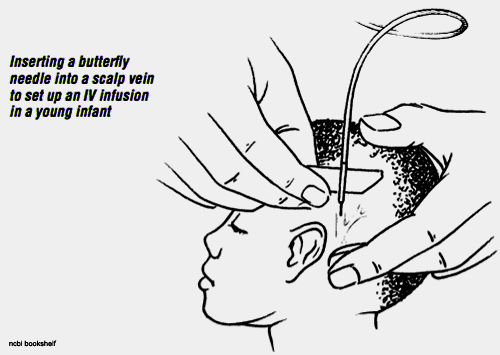The most effective and quickest way to deliver fluids and medicine to a sick infant or child is IV therapy. Relatively, this procedure is commonly performed in the pediatric unit. IV therapy can be used for the following reasons:
- Maintain fluid and electrolyte balance
- Quickly produce therapeutic drug levels in the body
- Provide rehydration
- Provide nutritional support
Intravenous (IV) fluids can be infused into a peripheral vein, a central venous access device or a peripherally inserted central venous catheter. The physician will prescribe the amount, type and rate of IV fluids for children to prevent fluid overload.
How to Determine the Fluid and Caloric Needs of a Child?
The IV fluid administered to infants and children are isotonic. Isotonic solution exerts the same osmotic pressure as the bloodstream which keeps the destruction of red blood cells or prevents water intoxication among the young ones. This solution prevents a pressure gradient which can lead to shifting of the fluids into the interstitial tissue which happens if the solution given is hypotonic. If the solution given to an infant is hypertonic, fluid will shift from the interstitial tissue to the bloodstream. Hence, only isotonic solutions are prescribed to infants such as Lactated Ringer’s and 0.9% normal saline.
The formula used in calculating water needed in children is for every 100 kcal expended in metabolism, a 115 mL of water, 3 Meq sodium and 2 mEq potassium must be replaced.
Pediatric IV Therapy
To choose an appropriate IV site, the nurse should consider the type and the duration of therapy. In addition, the rate of infusion and expected site rotations should be kept in mind too. The age of the child, size, and reason for the therapy, condition of the patient and veins, mobility, level of activity, motor skills and cognitive ability are additional considerations.
The appropriate sites for IV infusion in neonates include the scalp, hands, feet and forearms. In infants, the scalp is an excellent place to place an IV. It is east to stabilize and assess IV in this area and the scalp veins do not have valves making it easier to advance the catheter into the vessel. Veins in this site is visible and they can be distended by having the infant cry and using digital pressure at the base of the vein.
Equipment Needed:
- Sterile gloves
- Cleaning solution
- Cotton balls
- Shaver
- EMLA cream
- Tourniquet or rubber band
- Antiseptic solution
- Butterfly needles or scalp vein needle (22- to 25- gauge)
- Tape
- Gauze
Procedure:
- Wash hands and don gloves.
- Explain the procedure to the child’s parents to gain cooperation.
- Restrain the infant using a mummy restraint. Restraining the infant promotes safety. Trying to hold the infant’s arms and legs still is exhausting, hence, mummy restraint is used.
- Press the child’s head on the side and firmly hold it in that position. One hand should be on the occiput while the other is securing the front head. Make sure that the hand placed over the child’s face does not obstruct child’s breathing.
- With a cleaning solution, lather the area over the temporal bone to minimize the possibility of infection.
- Shave the child’s hair carefully on the site of insertion and inform the parents that the hair will just grow quickly. Shaving child’s hair allows the nurse to have clear view on the site.
- Apply EMLA cream to the site of insertion. EMLA cream reduces the discomfort during the procedure but takes some time to anesthetize the site.
- Place a tourniquet or rubber band around the infant’s head at the level of the forehead to dilate scalp veins.
- With an antiseptic solution, disinfect the shaved area to reduce risk of infection.
- Insert the butterfly needle. Make sure to use the required needle size.
- Securely tape the needle in place while holding the infant firmly.
- Cover the infusion site with a piece of gauze or a plastic protector taped onto the site. This keeps the infant from brushing the needle out of place when turning the head.
- Remove gloves and wash hands.
Pediatric and neonatal IV therapy is challenging yet a rewarding procedure. Mastering IV insertion skills in adult does not automatically make you an expert in children’s IV therapy. Most nurses have to ‘relearn’ the technique and make some adjustments to be able to successfully perform IV insertion techniques to the young ones.




![Caring for Patients with Tracheostomy and Nursing Diagnoses [ Updates] tracheostomynursingprocedure](https://rnspeak.com/wp-content/uploads/2020/10/tracheostomynursingprocedure_725820712-238x178.jpg)



